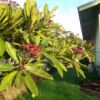If the decline is under genetic control, then that could be the result of programmed aging/death that many had mistakenly ascribed to the shortening of telomeres. The rapid fall-off of VSEL numbers at a specific age suggests a genetic rather than a purely stochastic effect. But what clock is keeping time if not telomeres? And if VSELs are using a telomeric clock after all, then an occasional use of a telomerase stimulant during fusion/C60 treatments would make sense. Though this would have to used very sparingly (perhaps once or twice a year), as telomeric lengthening of other dividing cells in the body will make you older, in my experience.
If VSELs are truly embryonic, then telomerase should be sufficient to avert telomere shortening. This telomere expression will be lost upon differentiation of course, due to epigenetic repression. So perhaps too many VSELs divide into two differentiating cells? Or some are lost through copying errors?
Symmetrical VSEL division (of the remainder) into 2 VSELs should be a solution to this.
As would be telomerase activation, though for the reason Turnbuckle gives, we'd ideally want only to activate telomerase in the VSELs. Interestingly there may be a way to do this, using TERC upregulation. This would only benefit cells that already have telomerase active.
Small-Molecule PAPD5 Inhibitors Restore
Telomerase Activity in Patient Stem Cells
https://www.cell.com...t/S1934-5909(20)30138-7?_returnURL=https%3A%2F%2Flinkinghub.elsevier.com%2Fretrieve%2Fpii%2FS1934590920301387%3Fshowall%3Dtrue
My take: The authors describe it this way: TERT is on/off switch, but TERC limits telomerase activity and decides telomere length. Stem cells can already pull the trigger. They just need a little more firepower.
For my part, I did some serious telomerase activation over the last year. I expect my VSELs benefited; this would be of a like benefit to increasing their numbers,only with a time delay, as with longer telomeres they will be able to expand to greater numbers. But because telomerase can (and was) activated in all downstream cells, epigenetic aging can result due to the expanded numbers of cells with various degrees of deranged methylation. And indeed this is what I experienced, age reversal as measured by telomere length, but an equal amount of extra epigenetic aging.
It's an open question whether this matters in the long run. So long as telomerase activation is ceased for long enough, the downstream cells will eventually be cleared, leaving the VSELs to benefit from a longer lease of life, if indeed they needed it.
Additionally, my experiment with telomerase activation did not seem to do me any harm: my workouts improved, and, if anything, I looked younger. But this was probably due to greater capacity for cell division. The cells themselves were not younger intrinsically (actually they were older).
I plan on seeing if I can reverse my epigenetic age, and then whether a balance can be found with telomerase activation. But I agree with Turnbuckle. For now I'd activate telomerase only once or twice a year until TERC activators become available as a better alternative.
On the protocol, as a relatively young person (41) I don't think senolytics would benefit me - I'd get the side effects without clearing many (if any) cells. But I like the idea of activating mTOR as a way of increasing cell turnover to get the expanded VSEL numbers to differentiate into the body. I have found branched chain amino acids (BCAAs) to be helpful for workouts and they boost my energy levels, which have been falling as I've used AKG and Turnbuckle's protocol.
What do you think, Turnbuckle?
Edited by QuestforLife, 18 August 2020 - 10:13 PM.


























































